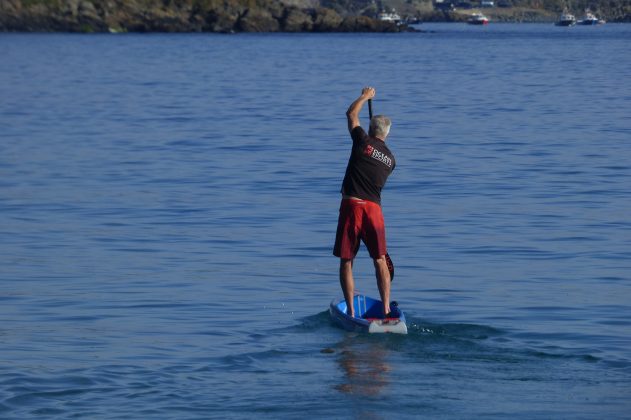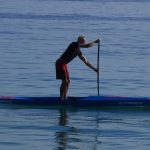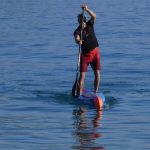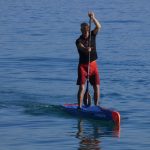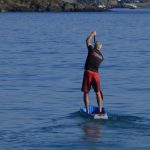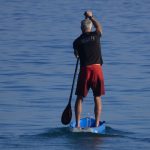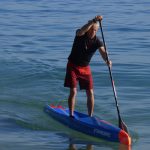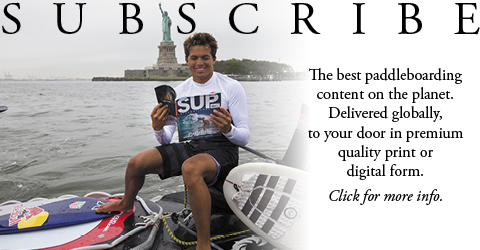PADDLE TECHNIQUE –
IT’S NOT ABOUT THE HINGE, IT’S ALL TORQUE!
With – Glenn Eldridge – oceansportscentre.co.uk
A common method to coach SUP technique is to hinge at the hips, drive power into the water and to stack the shoulders – this is an outdated method but produces some lovely Facebook profile pictures!
These are my thoughts on how to move technique forward in SUP. These are based upon my experience when I first started paddling SUP, casual conversations with some of the World’s best, Casper Steinfath, Jim Terrell and more recently Daniel Hasulyo and Sonni Honnscheid along with exercise professionals such as Physiotherapists, Sports Scientists and Biomechanists. Plus, reading around the area and watching plenty of footage of paddlers and other athletes from different sports.
Before you ask; what qualifies me to pass comment?
I paddle things! I have been fortunate enough to race internationally since 1994 for Great Britain in Surf Ironman and Ocean Ski and was part of the British Olympic Sprint Kayak squad, more recently I have competed at two World and European championships in SUP (distance and technical events). I hold a Masters Degree in Sports Science, written an undergraduate degree in Sports Science and Coaching, and have coached from grass roots through to elite international levels with athletes across all four paddle sports who have medalled at European and World levels.
- Here the paddler looks more balanced with torso more parallel to the deck of the board minimal rotation. Board is flatter on the water with more equal weight distribution across both rails.
- The familiar ‘stacked shoulders’ approach is a hangover from ocean ski and kayak paddling.
- Body positioning is more upright, shoulders are more relaxed with more elbow bend. Weight is distributed more evenly across both rails increasing stability and board performance.
- Increased shoulder stress on left plus, left hip being squeezed laterally which in turn adds greater weight to the left rail.
- Conservation of momentum. The Nordic technique delivers more force for forward propulsion.
- Start building new movement patterns into your sessions this winter. How long will it take for your peers to catch on?
General Principles
Where possible I try to simplify complex phenomena into simplified aspects – there are three key elements here:
1. What the craft does on / in the water
2. Production of the greatest force efficiently
3. Reduce potential for injury.
But, first, what are we actually talking about with SUP technique? Discussions often relate to paddling in general rather than specific aspects. In a race there are likely to be three different types of stroke, at least, e.g. stroke technique is different while sprinting – at the start of the race, pushing for a bump or runner or making a break from a group. Similarly, high end threshold pace several minutes after the start (using aerobic and anaerobic energy components in almost equal measure) technique in turn is also different in mid race slower grinds (almost extensively using oxygen – aerobic); stroke mechanics paddling in chop will be different to that on flat water, and female vs. male. The later point has important implications and needs a slight detour to expand. Rather than specify gender differences it is better to focus upon athletes with varying muscle mass and lever ratios e.g. arm span to height or leg to torso rather than absolute measures of height alone. For example, making gender generalisations means that if a female should paddle specific way or say a youngster what happens when that youngster or female exhibits the same or similar body morphology as a male? By lumping all of the above together serves only to convolute the situation. So where do we start?
Keeping it simple I will focus upon flat water high end threshold pace with a touch of grind! For now, lever length and body mass will be left to one side. Sprint and grinding are the topic for another article as is variances in morphology (body type) and optimal cadence (stroke rate). But first, I will address a broad understanding of how a board might move through the water. If a basic model can be formed, that allows a better grasp of how this might affect stroke mechanics or how stroke mechanics effect the board. I often look toward other sources of information that can help describe these patterns and will draw upon Nordic / Cross Country Skiing (XC) and structural engineering in the form of tensegrity – after all, few concepts are ever truly original, why reinvent the wheel when it has been done so several times to great effect.
Universal principles that apply to paddle sports:
1. To harvest energy from a system (glide in the recovery phase); we must first input energy to start the process (kinetic chains and power phase).
2. An object will continue along its path until another body acts upon it (board movement) – equal and opposite reaction.
3. Almost all race boards, at the speeds we paddle them, are displacement hulls (this does not include riding chop or waves).
4. The deeper an object sits in the water greater amounts of energy are required to overcome additional drag.
5. The further force is applied away from the centre line of an object, greater torque (turning force) is produced e.g. paddling on one side of a board.
6. The further away force generation is created (top hand is approximately two metres from the blade in the water and the bottom at least one metre) is from force application (blade in the water) torque is also increased.
Where it all starts: the board
The less we displace the board from its course the quicker it will go in a straight line. Using aeronautical terms, these come in the form of pitch (nose to tail), yaw (side to side – board flat) and roll (rail to rail). All three aspects are picked up in points 1, 2, 3, 4, 5 and 6. In short, we want a board to move across the surface of the water with the least amount of pitch (nose up tail down and nose down tail up), yaw, board profile is quicker nose first rather than allowing the board to rotate exposing the nose and significant portions of the rail and, roll, in general a board will move quicker and provide greater stability when rails are level instead of one rail sitting deeper than the other in the water. It is important to understand that these aspects cannot be eliminated, merely minimised as much as possible.
On to technique: The premise
What initially struck me was that we don’t seem to fully utilise our bigger muscles in the lower body as a source of locomotion effectively on the most part. I’m not talking about the deep squat and bouncing the board with our legs type of paddling, but we do seem to excessively hinge overlooking our hamstrings and use of glutes (our bum) which are a pretty big group of muscles. Instead smaller, less powerful and less fatigue resistant upper body muscle groups are favoured. In other words, we have relegated our prime movers (muscle groups that produce force to move things – locomotors) to stabilising and fixating roles (supporting prime moving muscle groups to reduce unnecessary movement). In turn, we appear to use less powerful fixator and stabilising muscles in the shoulder and lower back to become prime movers. To better move the board forward we need to ensure we use our whole body, minimising unnecessary board movement while using the appropriate muscle groups evolved for its role i.e. prime movers for locomotion and stabilisers and fixators for just that, stabilising and fixating across joints.
The Concept of Tensegrity and Nordic Technique
The body is truly an amazing organism able to transfer forces to enable us to move with greater speed and economy of movement than muscular contraction alone. Using track and field as an example, sport scientists quickly realised that 100m track athletes were running faster than the total amount of power that could be produced with skeletal muscle contraction alone. Broadly speaking, in the early 80’s scientists realised that potential and kinetic energy was at play. In other words, as the foot strikes the track the hamstrings load up with stored energy like elastic bands (potential energy) and then release this stored energy during the power phase of the stride (kinetic energy – energy in motion). A similar process is used when throwing an object – if you only need to throw a light object a short distance little force is required and you could throw it any which way you like. Change the weight and or the distance to be thrown and all of a sudden things change. Stop now, find a ball or similar object and throw it a short distance. Do it two more times, throw it as far as you can once. Throw again but stop just at the point of release. Take a look at how you are standing, and you will see that your body is ‘winding up’; one foot placed forward, torso rotating, shoulder behind you and your hand a long way behind your head. What’s cool about this is although you might not know the scientific name yet, intuitively you are using what are superficial slings, fibrous connective tissues which link various parts of your body together.
“The body is truly an amazing organism able to transfer forces to enable us to move with greater speed and economy of movement than muscular contraction alone.”
Like a track runner, the front foot loads up this sling, which by the way runs from the arch of your foot to the very top of your head, enabling you to produce greater power than muscular contraction alone and throw the object greater distances. In engineering the transfer of forces in structures with lower material integrity is called tensegrity. Hugely complex shapes and structures can be created under immense loading providing the system is closed e.g. forces can travel freely across the system of cables just like our superficial slings. It is vital that tension within the system, loading superficial slings within kinetic chains is not confused with body tension e.g. being tight say when your shoulders ride up toward your neck. In paddling when our hips excessively ‘pop out’, move laterally, we are no longer transferring energy effectively within the system. Similarly, over hinging beyond a given point when bending forward we again are no longer effectively transferring energy. So how does this work in paddling?
Sprint kayak or ocean ski paddlers can do this really easily because, they are sitting on their bums, driving their legs into their footrests to help load the system with greater potential energy. This combined with rotation of the torso transfers kinetic energy across the body, enabling greater transfer of force during the power phase of the stroke. A similar concept has been used within SUP by tacking the shoulders which is another way of creating rotation.
So, all good, or is it? Stand up, feet parallel as if stood on a board, stack your shoulders as if to take a stroke and notice how immediately your torso becomes rotated (points 5 & 6). Now draw your attention to the supporting leg (the one under your leading arm) notice how more weight is placed on this foot than the other, if you were on a board one rail would be lower than the other (the board would have rolled with one side deeper in the water than the other). Stacking the shoulders is a hangover from kayak, ocean skis and to a degree outrigger canoe paddling. Not only are we likely to lose balance but we are simply creating greater turning forces in our stroke (yaw). In short, slowing the board down. Equally important, we are more likely to increase the incidence of injury by over using our shoulders. Return to standing and the stacked position; whilst there place your hand on the shoulder that would be at the top of the paddle. If you have stacked your shoulders good and proper you should feel tension in that shoulder (deltoids). Now, holding the same position lower the elbow of the top arm, feel how tension is reduced in that shoulder. I call this compacting the stroke and I will elaborate on this latter, but it is drawn from Nordic skiing.
In summary, the issues with hinge and stacked shoulders are:
1. Encouraging thoracic rotation to lengthen the stroke and engage the latissimus dorsi (lats), rectus abdominis (six pack), internal and external obliques (love handles) along with erectus spinae (lower back muscle) brings greater rotational movement in the pelvis.
2. If thoracic rotation is being used it is essentially placing greater emphasis upon one side of the body.
3. By increasing length of stroke with rotation the hips become more engaged and also rotate. The net result is that then when carrying out the stroke to allow movement the pelvis must also move laterally in the opposite direction. In short, it squeezes out the opposite side of the paddle stroke resulting in a loss of power or tension within the system.
4. Balance is potentially affected. When extending with thoracic rotation combined with pelvic rotation greater emphasis is placed upon the supporting leg which in turn places greater weight upon one rail, easier to bog the rail in chop and easier to lose balance when tired.
5. Focusing upon power production from the upper body forces fixator and stabilising muscle groups to behave as prime movers – the issue is that these muscles have not evolved to generate masses of power and can become fatigued quickly.
6. Not only does hinging place excessive stress on the lumber region, L4 & 5 in particular, we are driving force into the water, increasing drag, slowing the board and therefore requiring greater force production to overcome resistance (point 4) rather than moving the board across it.
The solution; the Nordic technique!
Cross Country (XC) Double Pole method
XC skiing is one of the oldest Winter Olympic sports and as such has received a great deal of research from Sport Science Academics – by ‘borrowing’ findings from this sport and elements of technique it is possible to fast track technical development in the relatively new sport of SUP. Traditional XC skiing has used a variety of different poling techniques, single pole or classic style, skating (side to side) and more recently double poling. Classic poling methods encouraged similar principles of kayak technique, extend the ‘catch’ arm as far and as straight as possible out front and to hit the ground (catch) as hard as possible. Double poling moved away from this approach. Firstly, by bringing the arms closer to where power is being generated, closer to the body, with greater arm bend using the body rather than the shoulder girdle to generate power. Research has established that athletes with better double poling technique hit the ground with less force but generate greater force through the whole cycle and in particular toward later stages of the stroke cycle. Similarly, drawing upon Canadian sprint canoe (C1), a single bladed sport, can, in part, help to provide some answers, in particular, the use of the hips. C1 research has shown that this can actually increase velocity before the paddle even touches the water. Although this movement is quite significant in C1 a more subtle concept can be applied to SUP; driving the hips forward helps promote momentum between strokes. The common theme here is that in both sports when at the start of their respective stroke cycles (immediately prior to the catch) the pelvis is engaged forward. After quite a bit of thought (I started writing this three years ago!), combined with informal discussions with various people, Casper, Daniel Hasulyo and Jim Tyrell amongst the many, along with some interesting YouTube interviews, I feel ‘Nordic’ stroke has some mileage in it (a term I believe coined by Casper).
“XC skiing is one of the oldest Winter Olympic sports and as such has received a great deal of research from Sport Science Academics – by ‘borrowing’ findings from this sport and elements of technique it is possible to fast track technical development in the relatively new sport of SUP.”
So, what are the potential benefits to SUP?
1. The double pole method in particular, integrates the posterior kinetic chain capable of producing significant amounts of power by using more than just the hamstrings (gluteus maximus and quadriceps are also involved).
2. Power production through kinetic chains; the squat* – is one of the primary kinetic chains the body has evolved to carry out.
3. Injury prevention. If carried out with good technique this may well help prevent overuse injuries in the shoulder and lower back by compacting the stroke.
4. The highest recorded VO2max values are those of XC skier’s 92ml.kg.min (anything over 70ml.kg.min is considered elite) – this is because the whole body is being used.
* this is not referring to bouncing the knees however, one coaching method for the squat is to poke the bum put as if about to sit on a chair. This ‘micro’ movement in paddling has the potential to reduce incidence of lower back injury by protecting the lumbar region from acting like a hinge independent of more supportive muscle groups. In short, working as an integrative unit.
Nordic SUP, an integrative approach
It can be argued where peak power is developed in the stroke however, greater development of force by driving the pelvis forward at exit, enables larger more powerful muscle groups – locomotors (i.e. hamstring, quads and glutes) to become involved. Rather than hitting the catch by hinge alone, engaging the hips forward and parallel helps to ‘squeeze’ the stroke and allowing the board to travel across the surface rather bounce. An additional benefit is that greater muscle mass moves closer to the centre of gravity / balance enabling improved glide by maintaining momentum (point 1, harvesting energy from the system) – through the recovery phase. With a shortened cycle length cadence is increased (cadence or stroke rate is a whole area that will be covered in a different article – humans rarely select the most cost effective cadence or stroke rate) provided the athlete is able to
recover quickly enough (paddle ready for the next cycle). A way to reimagine this would be keep the chest more parallel to the deck of the board rather than trying to excessively reach, ‘compacting the stroke’.
There are a number of potential positives from adopting this type of movement pattern in SUP:
1. A quicker recovery with the pelvis moving forward could potentially help maintain board speed, in particular, deceleration between strokes
2. Promoting forward movement of the pelvis will improve posterior kinetic chain mechanics and power production. Potentially this would be due to improved position of the pelvis at the catch allowing engagement of larger muscle groups (gluts, quads and hamstrings) at a later point in the stroke.
3. ‘Fixing’ the hips so that they are parallel to the deck of the board along with the shoulder girdle will improve balance by placing more equal force across both legs rather than one.
4. In addition, by bringing the arms closer to the torso, lowering the shoulder girdle will help reduce undue stress in this area. So, what have we got to do? It is important to remember that the mechanics of the stroke phases do not change (exit, recovery, set up, entry, catch, power) however, developing new motor patterns or tweaking existing ones takes time and can only be done effectively on flat water and by moving slowly to start with.
Make the end the beginning!
• Focus upon exiting the water quickly and driving the pelvis forward. Not only are our hips vital in loading the system with potential energy, tension within the core and glutes facilitate greater kinematic energy transfer via posterior kinetic chains.
• Take time to set the stroke up, this gives the board a chance to do some work for you (harvesting energy from the system) by allowing it to glide.
• Momentum is conserved and deceleration reduced.
• Focus upon a ‘compact’ stroke during set up, entry and catch by allowing the arms to be closer to the body. Rather than an extended reach by rotating or stacking the shoulders keep the shoulder girdle and pelvis parallel to the deck of the board and arms ever so slightly bent.
• During the power phase allow the hamstrings and core to do the work by fixing the shoulders to the torso. Almost like drawing a bow, standing marginally taller drive the feet forward. Positive pressure is still maintained with the top hand driving downward. Squeeze the stroke.
• Repeat. Lots!
In summary, we want to move a craft efficiently through the water while producing the greatest amount of force and reducing incidence of injury. Excessive hinging compromises the core and the ability to transfer force through the body effectively (tensegrity) as does stacking the shoulders and rotation; the latter worse, as it generates greater turning forces (torque). Moving the pelvis forward helps to engage the posterior kinetic chain which in turn allows fatigue resistant primary movers (quads, glutes and hamstrings) to generate increased locomotive forces. Fixator and stabilising muscle groups, shoulder girdle, erector spinae and core also fall back into their respective roles. Locking the shoulder girdle into the torso, compacting the stroke by reducing over reaching improves balance and moderates unnecessary over use of the shoulders. Similarly, keeping both the shoulders and the pelvis parallel with the horizontal line of the deck has the potential to also improve balance. Use of the pelvis is key, driving forward on exit primes the system minimising bouncing the board, greater mass now moves closer to the centre of balance conserving momentum over the water rather than driving into it and reduces deceleration between strokes – with correct timing, overall speed can be increased as well as efficiency. SUP International

